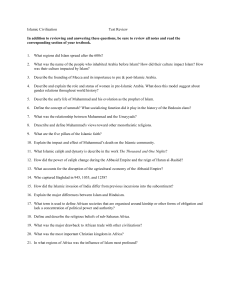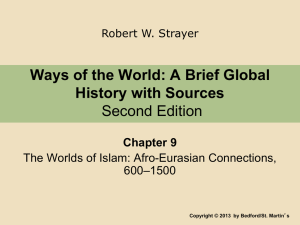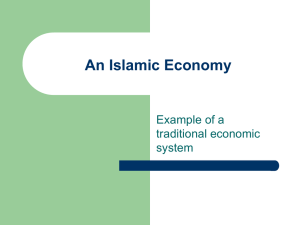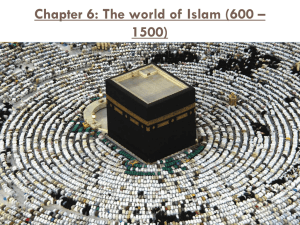Chapter 11 Study Guide Answer Key
advertisement
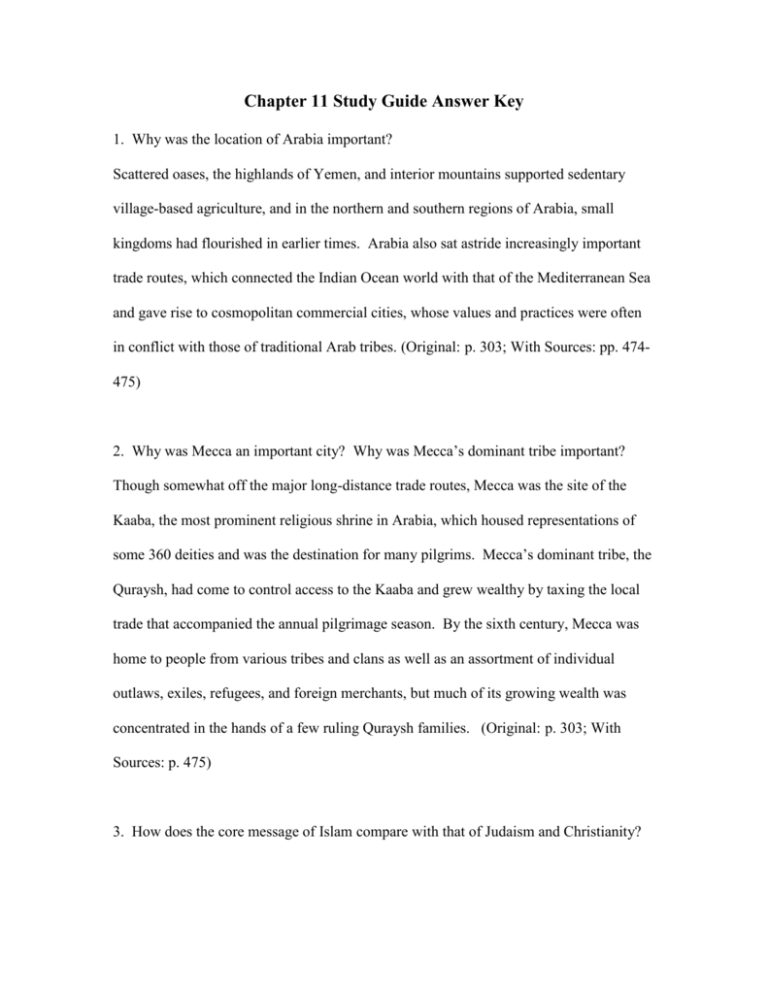
Chapter 11 Study Guide Answer Key 1. Why was the location of Arabia important? Scattered oases, the highlands of Yemen, and interior mountains supported sedentary village-based agriculture, and in the northern and southern regions of Arabia, small kingdoms had flourished in earlier times. Arabia also sat astride increasingly important trade routes, which connected the Indian Ocean world with that of the Mediterranean Sea and gave rise to cosmopolitan commercial cities, whose values and practices were often in conflict with those of traditional Arab tribes. (Original: p. 303; With Sources: pp. 474475) 2. Why was Mecca an important city? Why was Mecca’s dominant tribe important? Though somewhat off the major long-distance trade routes, Mecca was the site of the Kaaba, the most prominent religious shrine in Arabia, which housed representations of some 360 deities and was the destination for many pilgrims. Mecca’s dominant tribe, the Quraysh, had come to control access to the Kaaba and grew wealthy by taxing the local trade that accompanied the annual pilgrimage season. By the sixth century, Mecca was home to people from various tribes and clans as well as an assortment of individual outlaws, exiles, refugees, and foreign merchants, but much of its growing wealth was concentrated in the hands of a few ruling Quraysh families. (Original: p. 303; With Sources: p. 475) 3. How does the core message of Islam compare with that of Judaism and Christianity? Islam is monotheistic, as is Judaism and Christianity. Allah is the only God, the all-powerful Creator. As the “messenger of God,” Muhammad presented himself in the tradition of earlier prophets like Abraham, Moses, and Jesus. Like the Jewish prophets and Jesus, Muhammad demanded social justice and laid out a prescription for its implementation. (Original: p. 304-305; With Sources: pp. 476-477) 4. Why did the message of the Quran challenge the tribal and clan structure of Arab society? It not only challenged the ancient polytheism of Arab religion and the social injustices of Mecca but also the entire tribal and clan structure of Arab society, which was so prone to war, feuding, and violence. (Original: p. 305; With Sources: p. 477) 5. Explain the concept of the umma. The just and moral society of Islam was the umma, the community of all believers, replacing tribal, ethnic, or racial identities. Such a society would be a witness over the nations, for according to the Quran, “You are the best community evolved for mankind, enjoining what is right and forbidding what is wrong.” In this community, women, too, had an honored and spiritually equal place. The umma was to be a new and just community, bound by a common belief, rather than by territory, language, or tribe. (Original: p. 305; With Sources: p. 477) 6. Explain the five Pillars of Islam. A. There is no god but Allah, and Muhammad is the messenger of God. (absolute monotheism and a final revelation) B. prayer five times a day at prescribed times and performed while facing toward Mecca C. Believers are required to generously give their wealth to maintain the community and to help the needy. D. Ramadan is a month of fasting—no food, drink, or sexual relations—from the first light of dawn to sundown. E. pilgrimage to Mecca—the Hajj (Original: p. 305-306; With Sources: p. 478) The Transformation of Arabia 7. How was the umma different from the traditional tribes of Arab society? The umma was kind of a supertribe. Membership was a matter of belief rather than birth, allowing it to expand rapidly. This was very different from the traditional tribes of Arab society. Furthermore, all authority, both political and religious, was concentrated in the hands of Muhammad, who proceeded to introduce the radial changes. Usury was outlawed, tax-free marketplaces were established, and a mandatory payment to support the poor was imposed. (Original: p. 306; With Sources: p. 478) 8. In what ways was the young Islamic community seen as revolutionary and distinct from Christianity? The birth of Islam differed sharply from that of Christianity. Jesus’ teaching about “giving to Caesar what is Caesar’s and to God what is God’s” reflected the minority and subordinate status of the Jews within the Roman Empire. The answer lay in the development of a separate church hierarchy and the concepts of two coexisting authorities, one religious and one political, an arrangement that persisted even after the state became Christian. By contrast, the young Islamic community found itself constituted as a state, and soon a huge empire. Muhammad was not only a religious figure but also, unlike Jesus or the Buddha, a political and military leader able to implement his vision of an ideal Islamic society. Nor did Islam give rise to a separate religious organization. No professional clergy mediating between God and humankind emerged within Islam. Teachers, religious scholars, prayer leaders, and judges within an Islamic legal system did not have the religious role that priests held within Christianity. No distinction between religious law and civil law, so important in the Christian world, existed within the realm of Islam. (Original: p. 307; With Sources: p. 478) 9. In the centuries that followed, what civilizations became part of the new Arab state? The new Arab state became a huge empire, encompassing all or part of Egyptian, Roman/Byzantine, Persian, Mesopotamian, and Indian civilizations. (Original: p. 308; With Sources: p. 480) 10. Why were Arabs able to construct such a huge empire so quickly? For the first time, a shared faith in Islam allowed the newly organized state to mobilize the military potential of the entire Arab nation. The Byzantine and Persian empires were weakened by decades of war with each other and by internal revolts. They also underestimated the Arab threat. Merchant leaders of the new Islamic community wanted to capture profitable trade routes and wealthy agricultural regions. Individual Arabs found in military expansion a route to wealth and social promotion. Expansion provided a common task for the Arab community, which reinforced the fragile unity of the umma. Arabs were motivated by a religious dimension, as many viewed the mission of empire in terms of jihad, bringing righteous government to the peoples they conquered. (Original: p. 308-310; With Sources: pp. 480-482) 11. Why did the Battle of Talas River in 751 leave lasting consequences for Asia? Arab forces reached the Indus River and seized some of the major oases towns of Central Asia. In 751, Arab armies inflicted a crushing defeat on Chinese forces in the Battle of Talas River, which had lasting consequences for the cultural evolution of Asia, for it checked the further expansion of China to the west and made possible the conversion of Central Asia’s Turkic speaking people to Islam. (Original: p. 309; With Sources: p. 481) 12. Why did Muslims recognize Jews, Christians, and Zoroastrians as “people of the book?” By the middle of the eighth century, Arabs viewed Islam as a universal religion actively seeking converts, but even then they recognized Jews, Christians, and Zoroastrians as “people of the book.” This gave them the status of protected subjects and were free to practice their own religion, so long as they paid a special tax. (Original: p. 310; With Sources: p. 482) 13. What were the incentives for the conquered people to claim a Muslim identity? Slaves and prisoners of war were among the early converts, particularly in Persia. Converts could avoid the jizya, a tax imposed on non-Muslims. In Islam, merchants found a religion friendly to commerce, and in the Arab Empire they enjoyed a juge and secure arena for trade. People aspiring to official positions found conversion to Islam an aid to social mobility. (Original: p. 310; With Sources: p. 482) 14. What’s the difference between Shia and Sunni Islam? A central problem was that of leadership and authority in the absence of Muhammad’s towering presence. Who should hold the role of caliph, the successor to Muhammad? Caliphs were close companions to the Prophet Muhammad, selected by the Muslim elders of Medina. Division surfaced almost immediately as a series of Arab tribal rebellions and new “prophets” persuaded the first caliph, Abu Bakr, to suppress them forcibly. The third and fourth caliphs, Uthman and Ali, were both assassinated, and by 656, civil war pitted Muslim against Muslim. Shia—Shiites felt strongly that leadership in the Islamic world should derive from the line of Ali and his son Husayn, blood relatives of Muhammad. The Shia invested their leaders, known as imams, with a religious authority that the caliphs lacked, allowing them alone to reveal the true meaning of the Quran and the wishes of Allah. Sunni—Sunni Muslims, held that the caliphs were rightful political and military leaders, selected by the Islamic community, particularly from the religious scholars known as ulama. (Original: p. 311-312; With Sources: pp. 483-484) 15. Describe the first dynasty after the era of the Rightly Guided Caliphs. The first dynasty came from the Umayyad family (ruled 661-750). Under its rule, the Arab Empire expanded greatly, caliphs became hereditary rulers, and the capital moved from Medina to Damascus in Syria. Its ruling class was an Arab military aristocracy, drawn from various tribes. (Original: p. 312; With Sources: p. 484) 16. Why did Umayyad rule provoke growing criticism and unrest? The Shia viewed the Umayyad caliphs as illegitimate usurpers, and non-Arab Muslims resented their second-class citizenship in the empire. Many Arqabs protested the luxurious living and impiety of their rulers. (Original: p. 312; With Sources: p. 484) 17. What was the impact of the Abbasid rule after the overthrow of the Umayyad Dynasty? In 750, the Abbasids moved the capital to Baghdad and they presided over a flourishing and prosperous Islamic civilization in which non-Arabs, especially Persians, now played a prominent role. Persian cultural influence was reflected in a new title for he caliph, “the shadow of God on earth.” But the political unity of the Abbasid Empire didn’t last long. Beginning in the mid-ninth century, many local governors or military commanders effectively asserted the autonomy of their regions, while still giving formal allegiance to the caliph of Baghdad. The Islamic world had fractured politically into a series of sultanates, many ruled by Persian or Turkish military dynasties. (Original: p. 312-313; With Sources: pp. 484-485) 18. Who were the Sufis? A second and quite different understanding of the Islamic faith emerged among those who saw the worldly success of Islamic civilization as a distraction and deviation from the purer spirituality of Muhammad’s time. Sufis represented Islam’s mystical dimension, in that they sought a direct and personal experience of the divine. Through renunciation of the material world, meditation on the words of the Quran, the use of music and dance, the veneration of Muhammad and various saints, Sufis pursued the obliteration of the ego and spiritual union with Allah. (Original: p. 313; With Sources: p. 485) 19. In what ways were Sufi Muslims critical of mainstream Islam? To Sufis, establishment teachings about the law and correct behavior, while useful for daily living, did little to bring the believer into the presence of God. For some, even the Quran had its limits. They felt that many of the ulama had been compromised by their association with worldly and corrupt governments. Sufis, therefore often chartered their own course to God, implicitly challenging the religious authority of the ulama. (Original: p. 314; With Sources: p. 486) 20. How did the rise of Islam change the lives of women? Socially: The Quran provided a mix of rights, restrictions, and protections for women. The earlier Arab practice of infanticide was now forbidden. Women were given control over their own property, dowries, and were granted rights of inheritance, but at half the rate of their male counterparts. Marriage was a contract between consenting parties, thus making marriage by capture illegitimate. Divorce was possible for both parties, but was more readily available for men. In pre-Islamic Arab tribes, taking multiple husbands was legal, but now it was prohibited, while polygamy was permitted for husbands. Now veiling and the seclusion of women became standard practice among the upper and ruling classes, removing them form public life. Spiritually: In early Islamic times, a number of women played visible public roles. Women prayed in the mosques, although separately, standing beside the men. However, Islam offered new outlets for women in religious life. The Sufi practice of mystical union with Allah allowed a greater role for women than did mainstream Islam. Some Sufi groups had parallel groups for women, and a few welcomed them as equal members. In Shia Islam, women teachers of the faith were termed mullahs, like their male counterparts. Islamic education, either in the home or Quranic schools, allowed some to become literate. (Original: p. 315316; With Sources: pp. 487-488) 21. As Islamic empires spread through traditional Middle Eastern cultures, what were some signs of a tightening patriarchy? With no sanctions in the Quran or Islamic law, customs derived from local cultures crept into Islamic society, such as honor killing of women by their male relatives for violating sexual taboos, and in some places, clitorectomy. Women were viewed negatively, as weak, deficient, and a sexually charged threat to men and social stability. In any cultures, concern with family honor, linked to women’s sexuality, dictated harsh punishments for women who violated sexual taboos. (Original: p. 316; With Sources: p. 488) 22. Identify some similarities and differences in the spread of Islam to India, Anatolia, West Africa, and Spain. (Hint: How did Islam spread and was it the dominant faith?) Islam spread to India, Anatolia, and Spain in part through force of arms of Islamic armies, while Islam arrived in West Africa with Muslim traders. Sufis facilitated conversions by accommodating local traditions, especially in India and Anatolia, but played little role in West Africa until at least the 18th century. In India, West Africa, and Spain, Islam became one of several faiths within the wider culture, while in Anatolia it became the dominant faith. (Original: pp. 317-323; With Sources: pp. 489-495) 23. In what ways was Anatolia so much more thoroughly Islamized than India? By 1500, the population of Anatolia was 90% Muslim and largely Turkicspeaking. Anatolia was the heartland of the powerful Turkish Ottoman Empire that had overrun Christian Byzantium. The population—perhaps 8 million—was far smaller than India’s roughly 48 million people, but far more Turkic-speaking peoples settled in Anatolia, giving them a much greater cultural weight than the smaller colonizing force in India. Byzantine civilization in Anatolia focused on the centralized institutions of church and state, was rendered leaderless and dispirited, whereas India’s decentralized civilization, lacking a unified political or religious establishment, was better able to absorb the shock of external invasion while retaining its core values and identity. Anatolia built q new society that welcomed converts and granted them material rewards and opportunity for high office. Moreover, the cultural barriers to conversion were arguably less severe than in India. (Original: p. 319-320; With Sources: pp. 491-492) 24. Why was commerce in the Islamic world valued as a positive thing? Muhammad himself had been a trader, and the pilgrimage to Mecca likewise fostered commerce. The extraordinary spurt of urbanization that accompanied the growth of Islamic civilization also promoted trade. (Original: p. 325; With Sources: p. 497) 25. What ideas and technologies were diffused and exchanged as trade and commerce developed a “capitalist” economy that spanned the Old World? Agricultural practices and products included rice, sugarcane, new strains of sorghum, hard wheat, bananas, lemons, limes, watermelon, coconut palms, spinach, artichokes, and cotton. Some of these found their way into the Middle East and Africa. Both sugarcane and cotton came to play central roles in the formation of the modern global system after 1500. Technology also diffused with the ancient Persian techniques for obtaining water by drilling into the sides of hills; Muslim technicians made improvements on rockets, first developed in China; and papermaking techniques entered the Abbasid Empire from China in the eighth century. Likewise, ideas circulated across the Islamic world. Scientific, medical, and philosophical texts, especially form ancient Greece, the Hellenistic world, and India, were systematically translated into Arabic, for several centuries providing an enormous boost to Islamic scholarship and science. Using Indian numerical notation, Arab scholars developed algebra as a novel mathematical discipline. They also undertook much original work in astronomy and optics, They built upon earlier Greek and Indian practice to crate a remarkable tradition in medicine and pharmacology. (Original: p. 325-326; With Sources: pp. 497-498) 26. What did the journeys, of the travelers Ibn Battuta and Marco Polo, reveal about the world of the 13th and 14th centuries? What happened after 1700? They show that Islamic civilization was then the central fact of the Afro-Eurasian world, while Europe was still on the margins. After 1700, Europeans increasingly assumed the central role in world affairs. (Original: p. 329) Explain the significance of the following: Jihad—Arabic for “struggle,” this term describes the spiritual striving of each Muslim toward a godly life and armed struggle against the forces of unbelief and evil (Original: p. 306; With Sources: p. 478) Hijra—the flight of Muhammad and his original 70 followers form Mecca to Yathrib (Medina) in 622; the journey marks the starting point of the Islamic calendar (Original: p. 306; With Sources: p. 478) Sharia—Islamic law, dealing with all matters of both secular and religious life (p. 307; With Sources: p. 479) Dhimmis—protected subjects or “People of the book” under Islamic rule, non-Muslims who were allowed to practice their faith (Jews, Christians, etc.) in return for their paying special taxes (Original: p. 310; With Sources: p. 482) Jizya—special tax paid by dhimmis in Muslim-ruled territory in return for freedom to practice their own religion Original: (p. 310; With Sources: p. 482) Rightly Guided Caliphs—the first four rulers of the Islamic world (632-661) after the death of Muhammad; First-Abu Bakr. Second-Umar, Third-Uthman, Fourth-Ali (Original: p. 311; With Sources: p. 483) Ulama—Islamic religious scholars (Original: p. 312; With Sources: pp. 483-484) Imams—in Shia Islam, leaders with high religious authority; the 12 imams of early Shia Islam were Muhammad’s nephew Ali and his descendants (Original: p. 312; With Sources: p. 484) al Ghazali—a major Islamic thinker who was both a legal scholar and a Sufi practitioner. He incorporated Sufism into mainstream Islamic thinking. (Original: p.314; With Sources: p. 486) Hadiths—traditions passed on about the sayings or actions of Muhammad and his immediate followers; hadiths rank second only to the Quran as a source of Islamic law (Original: p. 316; With Sources: p. 488) Sikhism—a significant syncretic religion that evolved in India, blending elements of Islam and Hinduism; founded by Guru Nanak (1469-1539) (Original: p. 319; With Sources: p. 491) Ibn Battuta—fourteenth century Arab traveler who wrote about his extensive journeys throughout the Islamic world (Original: p. 320; With Sources: p. 492) The Great Mosque at Jenne— (Djenne) It was initially constructed in the 13th century in the city of Djenne in Mali. It’s the largest mud brick or adobe building in the world and is considered by many architects to be the greatest achievement of the SudanoSahelian architectural style, with definite Islamic influences. (Students will have to research elsewhere for this definition.) (Original: p. 322; With Sources: p. 494) Mozarabs— “would be Arabs” in Muslim-ruled Spain, referring to Christians who adopted much of Arabic culture and observed many Muslim practices without actually converting to Islam (Original: p. 323; With Sources: pp. 494-495)
